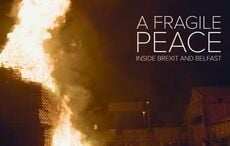Two days before Christmas in 1996, Sophie Toscan du Plantier, a 39-year-old aristocratic French beauty, was brutally murdered outside her cottage in West Cork in a still-unresolved case.
The new Netflix documentary Sophie: A Murder in West Cork reassembles the suspects and comes to shocking conclusions of its own in a brilliant three-part series that debuts on June 30.
Beautiful, cultured, and self-possessed, Du Plantier belonged to France's top tier, a member of the social elite who shunned the glamour of her high-born status in favor of an authentic life closer to nature and the elements.
Her love of Irish poetry (and a trip to Ireland in her youth) made the French TV producer fall hard for the country, with fateful consequences as the gripping new Netflix documentary 'Sophie – A Murder In West Cork,' makes clear.
Du Plantier's brutal murder outside her remote West Cork home in 1996 has become one of the country's most famous unresolved cases. How could so much violence visit such a peaceful region, locals wondered, where a murder hadn't been recorded in at least one hundred years?
Twenty-five years later, her killer has still not been brought to justice and this week director John Dower and producer Suzanne Lavery have produced a gripping three-part documentary that looks at the main suspects and what may really have happened.
For over two and a half decades, the murder has become a national obsession in Ireland and France, where the tensions between two very different justice systems have often played out publicly.
The new Netflix documentary has gained remarkable access both to the victim's family and to the English man who many consider to be the main suspect in the police investigation. The results are so powerful you are likely to watch the three episodes in one sitting.
Let's start with the facts. Two days before Christmas in 1996, near the small town of Toormore, County Cork, the body of Du Plantier was found by her neighbor Shirley Foster. Still dressed in her nightgown and boots, Du Plantier had been brutally beaten to death with a blood-stained cement block that was found nearby.
The state pathologist, based in Dublin, was unable to reach the rural murder scene for a shocking 28 hours, so her body was left outside in the elements. When he did examine her, he found her head injuries were so severe that even a neighbor was unable to identify her.
Clearly, it had been a frenzied attack. In fact, her skull had been crushed so badly even the attending police offers wept at the cruelty of it.
Shortly after her murder was announced, a journalist appeared at the crime scene. His name was Ian Bailey and he originally hailed from Manchester in England.
Bailey was one of the many “blow-ins” living in the West Cork community that is known for its tolerance and welcome to strangers. He himself was already known to his near neighbors for violent spousal abuse requiring surgery on his partner, leading to her hospitalization.
At the scene of the murder, Bailey only stopped for a short time to ask questions so odd that his manner was noted by the authorities. It wasn't long before they learned that he had called the Dublin papers with an on-the-scene exclusive that he had hastily written.
What worried investigators was that Bailey soon had knowledge known only to them, for example, he reported that the victim was French before her nationality had been announced, then later he reported that she had not been sexually assaulted, and soon he was using his national platform in the press to infer that she was conducting affairs with “multiple male companions” and had even hosted wild parties in her home (claims that neighbors who knew her comings and goings debunked).
Alarmingly, days after the murder, Bailey was observed to have scratches on his forearms and an injury to his forehead. He explained these wounds by claiming that he had cut down a Christmas tree on 22 December, the day that Du Plantier died. He added that a turkey he had killed for Christmas had accounted for the scratch to his forehead. But later, when investigators put his claims to the test and tried to replicate his injuries by cutting down a tree themselves, they failed to do so.
Read more
What is remarkable about Sophie – A Murder In West Cork is that despite its subject matter, it avoids all sensationalism. This isn't a Tiger King-type spectacle replete with melodramatic music and startling claims. Instead, it explores the testimony of the key witnesses and suspects, and it gives ample and necessary time for the grieving French family left behind too.
A word about that. When a child is lost to murder, more than one person experiences a life sentence, this hard-hitting show reminds us. The killer may be locked up, but so too are the people his or her actions have victimized, albeit in a prison without bars.
Du Plantier's grieving parents and her only son are, despite their perseverance, clearly heart shot and the camera lets you understand just how deeply they have been wounded by the theft of this daughter and mother. It's an important reminder that this is just a sensational murder case but a human tragedy, a needed rejoinder to the kind of tabloid coverage the case has often inspired.
Given unprecedented access to the prime suspect, the new Netflix show presents Bailey as a self-proclaimed eccentric. He had his start as a journalist in the 1970s when he bought a new home with his first wife in leafy Gloucester, until the marriage quickly failed and he was left, a colleague who knew him at the time tells us, penniless.
Ireland represented an opportunity to wipe the slate, it was an Edenic land that he planned to make himself over in, and soon he found a new partner and a new life in West Cork.
But the net of suspicion falls hard on him in the new documentary, as does the resolve of Du Plantier's surviving family members to see him brought to justice. (Bailey plans to sue Netflix for including his interviews in their finished documentary).
As her son, Pierre Louis, says to the camera in the documentary, “It’s clear he killed her. The judge said it. What happens next? I don’t know. If Bailey continues to slip through the net, I assure you I will make sure the net comes down on Bailey.”
Ireland has some uncomfortable truths to face up to. The Garda (police) investigation was filled with rookie errors from the outset. Why there was there no police lineup? Why did they allow crucial pieces of evidence such as the blood-stained gate discovered at the scene to be lost? Why did it 28 hours for the pathologist to arrive on scene, after their failure to properly protect all the evidence?
Equally, the Irish Department of Public Prosecution has a case to answer themselves. Yes, Bailey brutally beat his wife they said in their recommendation not to prosecute, but so too do many people. The burden of proof had not been met and without that, he could not be tried and convicted.
After watching Sophie – A Murder In West Cork, you may come away with a strong suspicion about who did it, but you won't have any doubt at all that the Irish government has a moral case to answer to in their handling and mishandling of this tragic and frightening tale.
Sophie – A Murder In West Cork debuts on Netflix on June 30.




Comments